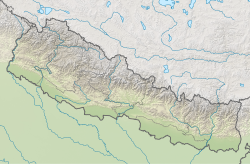Kapilavastu (ancient city)
Buddha's Holy Sites |
 |
Kapilavastu was an ancient city in the north of
Buddhist
Kapilavastu never became a major pilgrimage site like Buddha's birthplace at
Search for Kapilavastu
The 19th-century search for the historical site of Kapilavastu followed the accounts left by Faxian and later by Xuanzang, who were Chinese Buddhist monks who made early pilgrimages to the site.[6][7][8][9] Some archaeologists have identified present-day Tilaurakot, Nepal, while others have identified present-day Piprahwa, India as the location for the historical site of Kapilavastu, the seat of governance of the Shakya state that would have covered the region.[10][11][12] Both sites contain archaeological ruins. Those at Piprahwa show it was a significant early Buddhist site with a stupa and monasteries, and probably relics of the Buddha.[5][13][14][15]
Proposed sites
-
Proposed site of Suddhodanda's Palace at Tilaurakot
-
Stupa at Piprahwa
Ancient depictions
-
Maya's dream of an elephant during her conception of the Buddha, an identifier of the city of Kapilavastu.
-
The departure of the Buddha from Kapilavastu, Sanchi, Stupa 1, Northern Gate.
See also
- Banganga River - river passing through Kapilavastu
References
- ^ Marshall, John (1918). Guide To Sanchi, Calcutta: ASI; p.64]
- ^ ISBN 978-0-415-55624-8.
- ^ Kapila, PTS Pali English Dictionary. Link: https://suttacentral.net/define/kapila
- ^ Suttacentral
- ^ a b Srivastava, KM (1980). "Archaeological Excavations at Piprāhwā and Ganwaria and the Identification of Kapilavastu". The Journal of the International Association of Buddhist Studies. 13 (1): 103–10.
- Beal, Samuel (1884). Si-Yu-Ki: Buddhist Records of the Western World, by Hiuen Tsiang. 2 vols. Translated by Samuel Beal. London. 1884. Reprint: Delhi. Oriental Books Reprint Corporation. 1969. Volume 1
- ^ Beal, Samuel (1911). The Life of Hiuen-Tsiang. Translated from the Chinese of Shaman (monk) Hwui Li by Samuel Beal. London. 1911. Reprint Munshiram Manoharlal, New Delhi. 1973. Internet Archive
- ISBN 1-886439-02-8
- ^ Watters, Thomas (1904). On Yuan Chwang's Travels in India, 629-645 A.D. Volume1. Royal Asiatic Society, London.
- ^ Tuladhar, Swoyambhu D. (November 2002), "The Ancient City of Kapilvastu - Revisited" (PDF), Ancient Nepal (151): 1–7
- Archaeology.org. Retrieved 21 March 2011.
- (subscription required)
- ^ Sharda, Shailvee (4 May 2015), "UP's Piprahwa is Buddha's Kapilvastu?", Times of India
- ^ "Kapilavastu". Retrieved 1 March 2011.
- ^ Huntington, John C (1986), "Sowing the Seeds of the Lotus" (PDF), Orientations, September 1986: 54–56, archived from the original (PDF) on 28 November 2014
Bibliography
- ISBN 978-1-316-41898-7.






